Which event contributed to the U.S. entry into World War I?
A. the sinking of the Lusitania
B. the attack on Pearl Harbor
C. the explosion of the Maine
D. the fall of Saigon
the sinking of the Lusitania
Use the excerpt below to answer the question.
When I addressed the Congress on the twenty-sixth of February last I thought that it would suffice to assert our neutral rights with arms, our right to use the seas against unlawful interference, our right to keep our people safe against unlawful violence. But armed neutrality, it now appears, is impracticable.—President Woodrow Wilson’s Joint Address to Congress, 1917
Which factor contributed most to the policy change described in this excerpt?
A. the possibility of an invasion of U.S. territory
B. the German use of unrestricted submarine warfare
C. the success of the U.S. isolationist position
D. the German use of naval blockades
the German use of unrestricted submarine warfare
 This quote is from the majority opinion in the Supreme Court case of Schenck v. U.S.
This quote is from the majority opinion in the Supreme Court case of Schenck v. U.S.
This quote was used to justify what action of the United States government during World War I?
A. making it illegal to yell "fire" in public if there's not really a fire
B. arresting an American citizen for passing out anti-war pamphlets
C. refusing to allow the U.S. to enter into WW1 due to isolationism
D. arresting an American citizen for purposefully infringing on another citizen's right to free speech by making him afraid to do so.
arresting an American citizen for passing out anti-war pamphlets
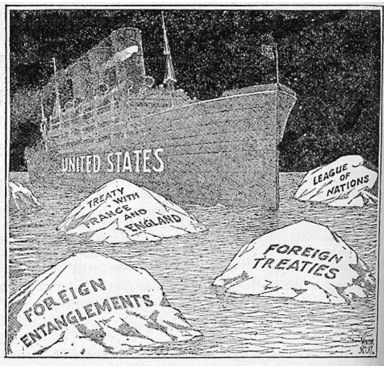 What message about United States foreign policy after World War I is this cartoonist expressing?
What message about United States foreign policy after World War I is this cartoonist expressing?
A. The United States needed to adopt an isolationist policy.
B. The United States needed to protect its access to the seas.
C. The United States needed to show its naval superiority.
D. The United States needed to take a more active role in foreign affairs.
The United States needed to adopt an isolationist policy.
Senator Henry Cabot Lodge opposed which feature of the Treaty of Versailles?
A. the territories of Alsace and Lorraine being returned to France
B. Germany being required to accept sole responsibility for World War I
C. governing of surrendered colonies by certain states under the mandate system
D. the committing of signatories to protect the independence of other member states
the committing of signatories to protect the independence of other member states
What was a reason why the United States entered World War I on the side of the Allies?
A. Germany returned to unrestricted submarine warfare.
B. Russia entered the war on the side of Germany.
C. London had been attacked by the Germans.
D. Germany developed atomic weapons.
Germany returned to unrestricted submarine warfare.
What was one of Woodrow Wilson’s goals for peace following World War I?
A. ending the system of secret alliances
B. supplying humanitarian aid to citizens
C. stabilizing global monetary systems
D. ending popular democratic revolutions
ending the system of secret alliances
What action did the Senate take after World War I to promote a policy of isolationism for the United States?
A. It ratified the Treaty of Versailles quickly to bring an end to the war even faster.
B. It added an amendment to the Treaty of Versailles that stated that the U.S. would NOT get involved with another European conflict...periodt!
C. It refused to ratify the Treaty of Versailles.
D. It forced Wilson to ratify the Treaty of Versailles, even though he didn't want to.
It refused to ratify the Treaty of Versailles.
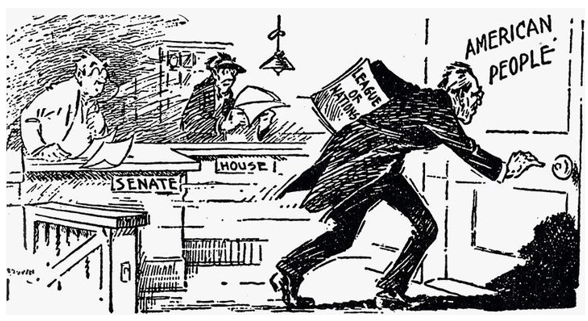 This cartoon is reflective of what strategy used by President Woodrow Wilson to increase support for the ratification of the Treaty of Versailles?
This cartoon is reflective of what strategy used by President Woodrow Wilson to increase support for the ratification of the Treaty of Versailles?
A. encouraging citizens to support the treaty
B. repealing the League of Nations provision in the treaty
C. proposing a constitutional amendment to change the ratification process
D. compromising with Senators who were opposed to the treaty
encouraging citizens to support the treaty
Which statement is a criticism made by isolationists in the U.S. Senate about the Treaty of Versailles?
A. Reparation payments would involve the United States in European economies.
B. The League of Nations would involve the United States in future conflicts.
C. Stationing U.S. soldiers in Europe would be necessary to maintain peace.
D. The mandate system for colonial independence would result in loss of U.S. territory.
The League of Nations would involve the United States in future conflicts.
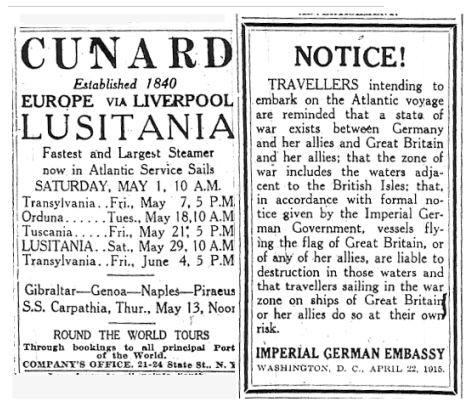 What cause of America's involvement in World War I is illustrated by this advertisement?
What cause of America's involvement in World War I is illustrated by this advertisement?
A. the capture of American ships by the British Navy
B. the alliance between Germany and Austria-Hungary
C. the desire by Austria-Hungary to seek revenge for the assassination of Archduke Ferdinand
D. the use of unrestricted submarine warfare by the Germans
the use of unrestricted submarine warfare by the Germans
Use the excerpt below to answer the question.
A general association of nations must be formed under specific covenants for the purpose of affording mutual guarantees of political independence and territorial integrity to great and small states alike. . . . We cannot be separated in interest or divided in purpose. We stand together until the end.—“Fourteen Points,” President Woodrow Wilson, 1918
Why did the U.S. Senate reject membership in this organization?
A. concern over the possibility of arms control treaties
B. risk of being dependent on global markets
C. fear of becoming involved in foreign conflicts
D. concern over the ability to defend against attacks
fear of becoming involved in foreign conflicts
What was the overarching purpose of President Wilson’s Fourteen Points?
A. to make sure that the U.S. was never involved in another major conflict
B. to quickly end WW1
C. to put the U.S in a strong position of power
D. to maintain peace after the war ended
to maintain peace after the war ended
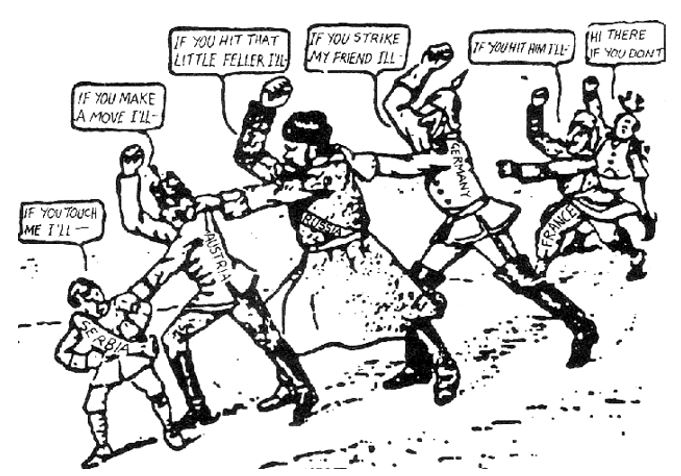 This political cartoon was published in The Brooklyn Eagle newspaper in July 1914.
This political cartoon was published in The Brooklyn Eagle newspaper in July 1914.
What cause of World War I is demonstrated by this cartoon?
A. alliances
B. imperialism
C. militarism
D. nationalism
alliances
Use the excerpt below to answer the question.
The Members of the League undertake to respect and preserve as against external aggression the territorial integrity and existing political independence of all Members of the League. In case of any such aggression or in case of any threat or danger of such aggression the Council shall advise upon the means by which this obligation shall be fulfilled.
—“Article X,” The Covenant of the League of Nations, 1919
Which statement best describes why the U.S. Senate opposed joining this organization?
A. It would have limited the territorial expansion of the United States.
B. It would have reduced the ability of the United States to fulfill trade agreements.
C. It would have prevented the military from defending U.S. territories.
D. It would have limited the ability of the United States to establish independent foreign policy.
It would have limited the ability of the United States to establish independent foreign policy.
Incidents such as the sinking of the Lusitania and the discovery of the Zimmermann Note had what impact on the United States?
A. They convinced the United States to withdraw all aid to the Allied Powers.
B. They reinforced the United States’ commitment to remaining neutral.
C. They shifted public sentiment in favor of entering the war in Europe.
D. They caused President Wilson to lose his reelection bid.
They shifted public sentiment in favor of entering the war in Europe.
Which postwar attitude in the United States represented opposition to this proposal?
A general association of nations must be formed under specific covenants for the purpose of affording mutual guarantees of political independence and territorial integrity to great and small states alike. —President Woodrow Wilson, Fourteen Points Speech
A. support for the spread of democracy
B. the promotion of isolationist policies
C. support for an expanded alliance system
D. the endorsement of imperialistic acquisitions
the promotion of isolationist policies
To support his goal of creating a lasting peace, what provision did President Wilson include as part of his Fourteen Points?
A. the establishment of the Justice League
B. to make sure that women had a League of Their Own
C. the establishment of the League of Extraordinary Gentlemen
D. the establishment of the League of Nations
the establishment of the League of Nations
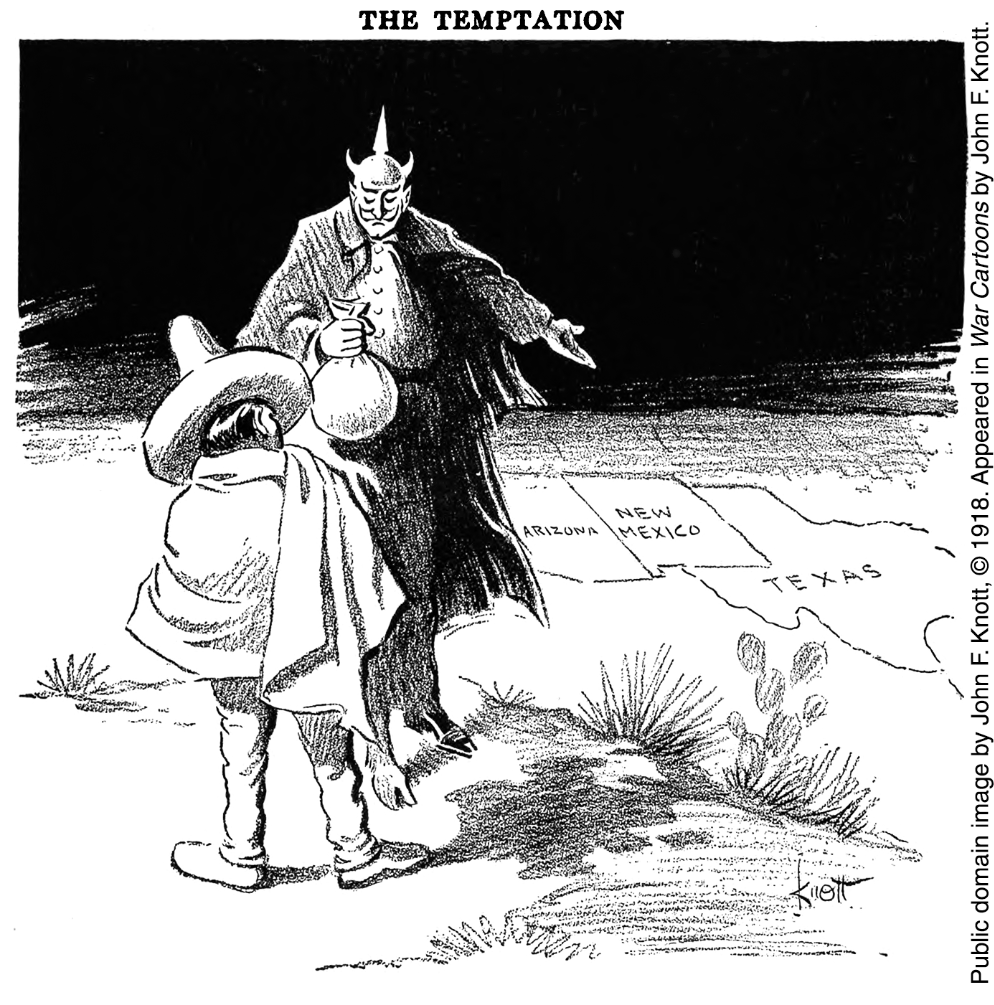 The cartoonist would most likely agree that the United States:
The cartoonist would most likely agree that the United States:
A. failed to provide military forces it had committed to an international conflict.
B. angered world leaders by taking control of an international organization.
C. refused to provide funds to rebuild world capitals.
D. declined to take steps to preserve world peace.
declined to take steps to preserve world peace.
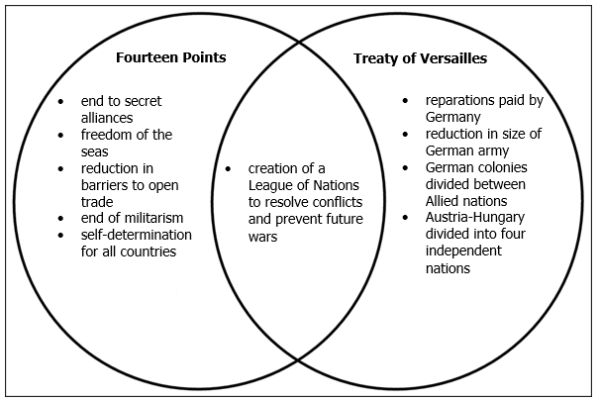 Based on this Venn diagram, how did the Fourteen Points differ from the Treaty of Versailles?
Based on this Venn diagram, how did the Fourteen Points differ from the Treaty of Versailles?
A. The Fourteen Points sought to punish the Central Powers for World War I.
B. The Fourteen Points sought to create a lasting peace without penalizing the Central Powers.
C. The Fourteen Points sought to gain the most possible power for the United States.
D. The Fourteen Points sought to divide control of the seas among the Allied Powers.
The Fourteen Points sought to create a lasting peace without penalizing the Central Powers.
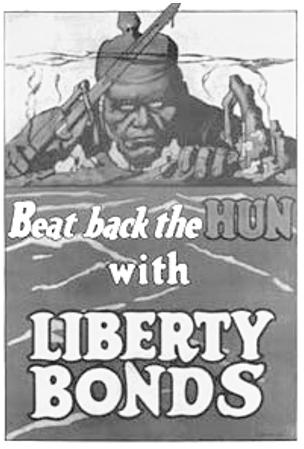 This poster is evidence of what tactic used by the United States to gain support for the war effort?
This poster is evidence of what tactic used by the United States to gain support for the war effort?
A. conscription
B. propaganda
C. voluntary rationing
D. yellow journalism
propaganda
Why did President Wilson authorize the formation of the Creel Committee on Public Information during World War I?
A. to ensure that rationing laws were enforced
B. to keep Americans informed about events going on in Europe
C. to sway public opinion from supporting neutrality to supporting the war
D. to increase regulation of the economy during wartime
to sway public opinion from supporting neutrality to supporting the war
How was U.S. foreign policy changed after the Senate refused to ratify the Treaty of Versailles at the end of World War I?
A. The U.S. focused on trade relations with Asian nations rather than in European nations.
B. The U.S. became more isolationist and took a smaller role in world affairs.
C. The U.S. provided military assistance to African nations trying to end colonial rule.
D. The U.S. provided humanitarian aid to new nations in Europe.
The U.S. became more isolationist and took a smaller role in world affairs.
 The cartoon was published in 1917. The figure in black represents Kaiser Wilhelm II. The situation shown in the cartoon led directly to which of these events?
The cartoon was published in 1917. The figure in black represents Kaiser Wilhelm II. The situation shown in the cartoon led directly to which of these events?
A. a declaration of war on Mexico by the United States
B. a declaration of war on Germany by the United States
C. the annexation of southwest territories by the United States
D. the establishment of a naval blockade around the United States
a declaration of war on Germany by the United States
How was U.S. foreign policy changed after the Senate refused to ratify the Treaty of Versailles at the end of World War I?
A. The U.S. focused on trade relations with Asian nations rather than in European nations.
B. The U.S. became more isolationist and took a smaller role in world affairs.
C. The U.S. provided military assistance to African nations trying to end colonial rule.
D. The U.S. provided humanitarian aid to new nations in Europe.
The U.S. became more isolationist and took a smaller role in world affairs.